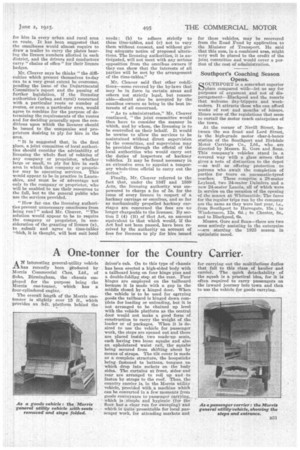A One-tonner for the Country Carrier.
Page 15

If you've noticed an error in this article please click here to report it so we can fix it.
AN interesting general-utility vehicle has recently been produced by Morris Commercial Cars, Ltd., of Soho, Birmingham, the chassis employed for the purpose being the Morris one-tonner, which has a four-cylindered engine.
The overall length of the Morris onetonner is slightly over 15 ft, which provides an &ft. platform behind the
driver's cab. On to this type of chassis has been erected a high-sided body with a tailboard hung on four hinge pins and a double-folding step at the rear. Four hinges are employed on the tailboard because it is made with a gap in the middle closed by a hinged door. When the vehicle is to be used for carrying goods the tailboard is hinged down complete for loading or unloading, but it is not arranged to be chained up level with the vehicle platform as the central door would not make a good form of construction to carry the weight of the loader or of packages. When it is desired to use the vehicle for passenger work, the steps are opened out and there are placed inside two made-up seats, each having two loose squabs and also an upholstered waist rail, the' squabs being secured from shifting about by means of straps. The tilt cover is made as a complete structure, the hoopsticks being fastened to battens, tongues on which drop into sockets on the body sides. The curtains at front, sides and rear are arranged to roll up and • to fasten by straps to the roof. Thus, the country carrier is, in the Morris utility vehicle, provided with a machine which can be converted in a few moments from goods conveyance to passenger carrying, which is simple and hygienic (for the floor hasa clear run for Sweeping) and which is quite presentable for local passenger work, for attending markets and
for carrying out the multifarious duties that fall to this class of haulier and carrier. The quick detachability of the squab is a practical idea, for it is often required to carry passengers on the inward journey into town and then to use the vehicle for goods carrying.




























